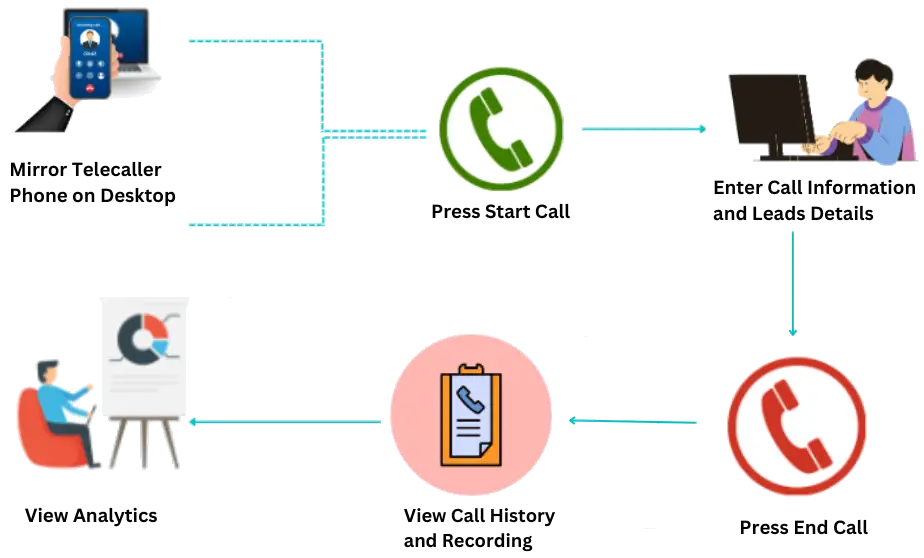What is Telecalling? | Telecalling Software For Business
Maximizing Business Success with Advanced Telecalling Software

Understanding Telecalling
Telecalling refers to the practice of reaching out to potential customers or clients via telephone calls. It is an integral component of telemarketing, which encompasses a range of marketing activities conducted over the phone. Telecalling is employed by businesses to generate leads, provide customer support, conduct surveys, and promote products or services. This method of communication is direct, personal, and can be highly effective when executed correctly.

The Importance of Telecalling in Modern Business
In today’s fast-paced business environment, Tele-calling serves as a critical touchpoint between companies and their customers. It allows businesses to build relationships, gather feedback, and drive sales. Telecalling offers several advantages:
Personal Interaction:
Unlike emails or social media, Tele-calling allows for real-time, personal interactions, making it easier to address customer concerns and build rapport.
Immediate Feedback:
Telecallers can obtain immediate feedback from customers, which can be invaluable for market research and improving products or services.
Cost-Effective:
Telecalling is a relatively low-cost marketing strategy compared to other forms of advertising such as TV or print media.
Types of Telecalling
Telecalling can be broadly categorized into **inbound** and **outbound** telecalling:
Inbound Telecalling
Inbound telecalling involves handling incoming calls from customers. These calls are usually inquiries, support requests, or service-related issues. Key aspects include:
Customer Support:
Providing assistance with product usage, troubleshooting, and resolving complaints.
Order Processing:
Taking orders for products or services over the phone.
Information Requests:
Responding to customer inquiries about products, services, or company information.
Outbound Telecalling
Outbound telecalling, on the other hand, involves proactive calls made by the telecaller to potential or existing customers. Key activities include:
Lead Generation:
Identifying and qualifying potential customers for sales follow-up.
Sales Calls:
Promoting and selling products or services directly over the phone.
Surveys and Feedback:
Conducting surveys to gather customer opinions and feedback.
Key Features of Effective Telecalling
To be effective, **Tele-calling** must incorporate several key features:
Scripted Communication:
Well-crafted scripts help telecallers convey the right message and handle objections efficiently.
Training:
Comprehensive training programs ensure telecallers are knowledgeable about the product or service and skilled in communication techniques.

CRM Integration:
Integrating Customer Relationship Management (CRM) systems helps in tracking customer interactions and managing leads.
Performance Monitoring:
Regular monitoring and evaluation of telecallers’ performance help in maintaining high standards of service.
Challenges in Telecalling
While Tele-calling offers numerous benefits, it also presents certain challenges:
Rejection:
Telecallers often face high levels of rejection, which can be demotivating.
Compliance:
Adhering to regulations such as Do Not Call (DNC) lists and privacy laws is critical.
Quality Control:
Ensuring consistent quality in customer interactions can be difficult, especially in large teams.
Introduction to Telecalling Software
To overcome these challenges and enhance the efficiency of Tele-calling operations, businesses increasingly rely on **Tele-calling software**. These software solutions offer a range of features designed to streamline Tele-calling processes and improve outcomes.
Features of Telecalling Software
Effective Tele-calling software includes a variety of features:
Auto-Dialers
Auto-dialers automatically dial numbers from a predefined list, reducing the time telecallers spend dialing numbers manually. This feature significantly increases productivity by allowing telecallers to focus more on conversations rather than dialing.
Call Recording
Call recording capabilities enable businesses to record conversations for quality assurance and training purposes. This feature helps in monitoring performance and ensuring compliance with regulatory standards.
CRM Integration
Seamless integration with CRM systems allows telecallers to access customer data, track interactions, and manage leads efficiently. This integration ensures that telecallers have all the necessary information at their fingertips, enhancing customer interactions.
Analytics and Reporting
Advanced analytics and reporting tools provide insights into call metrics, such as call duration, success rates, and customer feedback. These insights help in evaluating performance and identifying areas for improvement.
Interactive Voice Response IVR
IVR systems route incoming calls to the appropriate departments or telecallers, ensuring that customers reach the right person quickly. This feature improves customer satisfaction by reducing wait times and enhancing the overall experience.
Benefits of Using Telecalling Software
Implementing telecalling software offers several advantages:
Increased Efficiency:
Automation of repetitive tasks, such as dialing and data entry, allows telecallers to focus on conversations.
Enhanced Quality Control:
Features like call recording and real-time monitoring help maintain high standards of service.
Better Data Management:
CRM integration ensures accurate and up-to-date customer information, leading to more personalized interactions.
Improved Compliance:
Telecalling software often includes features that help businesses comply with regulations, such as DNC list management and consent tracking.
Scalability:
As businesses grow, telecalling software can scale to accommodate larger teams and higher call volumes.
Selecting the Right Telecalling Software for Your Business
Choosing the right Tele-calling software is crucial for maximizing the benefits and achieving business goals. Here are some factors to consider:
Ease of Use
The software should be user-friendly, with an intuitive interface that telecallers can easily navigate. This reduces the learning curve and enhances productivity.
Customizability
Look for software that can be customized to meet your specific business needs. This includes the ability to create custom scripts, workflows, and reports.
Integration Capabilities
Ensure the software integrates seamlessly with your existing systems, such as CRM, email, and other communication tools. This integration is essential for efficient data management and streamlined operations.
Support and Training
Reliable customer support and comprehensive training resources are vital for the successful implementation and ongoing use of the software. Choose a provider that offers robust support and training options.
Cost
Consider the total cost of ownership, including subscription fees, setup costs, and any additional charges for features or upgrades. Balance cost with the value provided by the software to ensure a good return on investment.
Conclusion
In conclusion, Tele-calling remains a powerful tool for businesses seeking to enhance customer engagement, generate leads, and drive sales. By leveraging advanced Tele-calling software, companies can overcome challenges, improve efficiency, and deliver exceptional customer experiences. Selecting the right software, tailored to your business needs, will ensure that your Tele-calling efforts are successful and sustainable in the long term.



